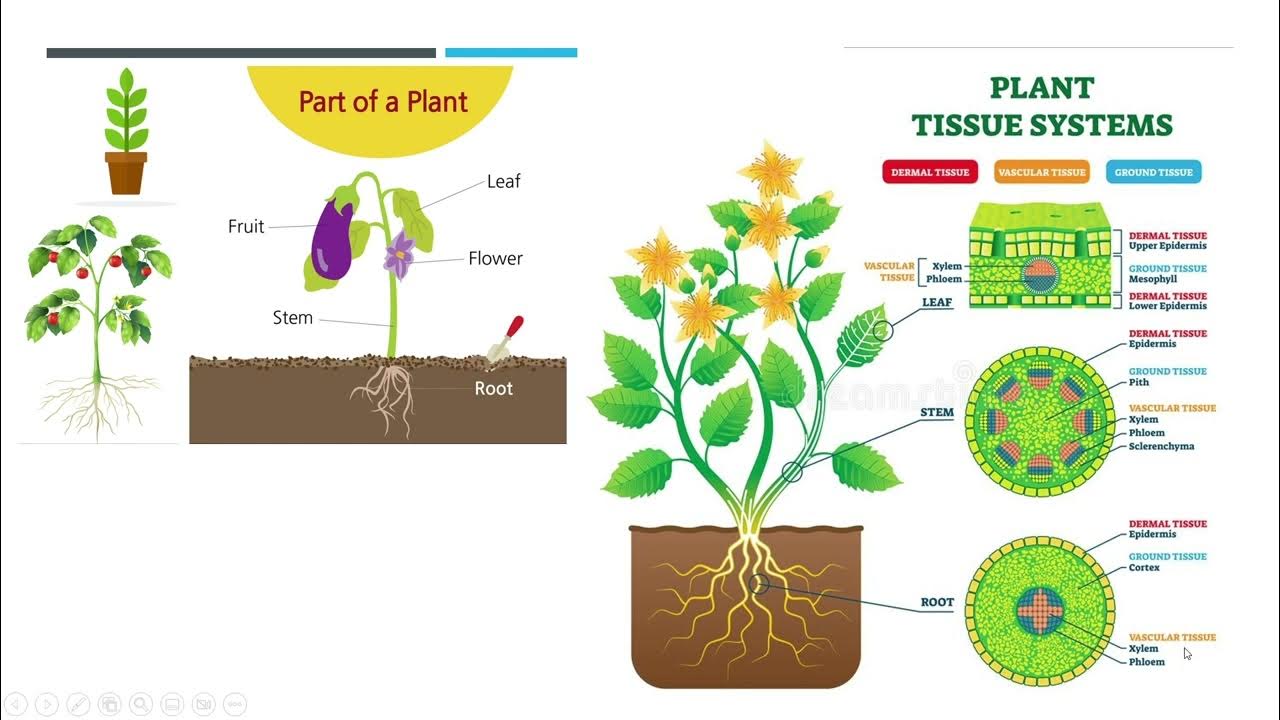7-1 Types of Dicotyledon Plant Tissues (Cambridge AS A Level Biology, 9700)
Summary
TLDRThis video covers Chapter 7 on transport in plants, focusing on plant tissues and their functions. The instructor revises the importance of transport systems in multicellular plants, explaining how these systems reduce diffusion distances and facilitate the movement of water and minerals. Key plant tissues are introduced: the epidermis (protective outer layer), vascular tissues (xylem and phloem for transport), and ground tissues (support structures like parenchyma, sclerenchyma, and collenchyma). Visual aids help illustrate the tissue locations and roles in plant structure and support, while future videos will explore more details.
Takeaways
- 🌿 Multicellular plants require transport systems because diffusion alone is insufficient due to low surface area to volume ratios.
- 🟢 The plant's transport system helps minimize the diffusion distance, making it easier for minerals and water to move throughout the plant.
- 🌸 Plant tissues are classified into three main types: epidermal tissues, vascular tissues, and ground tissues.
- 🧬 Epidermal tissues, similar to skin, are the outermost layer of the plant, providing protection against pathogens and environmental damage.
- 🌱 Vascular tissues include xylem and phloem, which function as tubes for transporting water and nutrients within the plant.
- 🌰 Ground tissues encompass all tissues that are not part of the epidermis or vascular system, including parenchyma, sclerenchyma, and collenchyma.
- 📦 Parenchyma tissues act as packing tissues, supporting the plant’s roots, stems, and leaves through turgor pressure.
- 🔧 Sclerenchyma tissues are lignified, dead tissues providing structural support to the plant, particularly near vascular bundles.
- 🧱 Collenchyma tissues have thickened cell walls, often found in leaf veins, helping to strengthen these areas.
- 🧪 Endodermis is another ground tissue found mainly in roots, and its cell walls contain a Casparian strip, which controls water movement in the plant.
Q & A
What is the main challenge students face when learning about transport in plants?
-Students often struggle with understanding the variety of tissues in plants, such as parenchyma, sclerenchyma, xylem, phloem, epidermis, and endodermis, which can make plants seem more complicated than they actually are.
Why do multicellular organisms like plants need transport systems?
-Multicellular organisms need transport systems because diffusion alone is not sufficient to move substances like minerals and water throughout the plant due to the low surface area to volume ratio and large diffusion distances.
What are the main types of plant tissues mentioned in the script?
-The main types of plant tissues are the epidermis (epidermal tissues), vascular tissues (xylem and phloem), and ground tissues.
What is the function of the epidermis in plants?
-The epidermis acts as the outermost protective tissue of the plant, similar to skin, preventing pathogens from entering and protecting the plant's internal structures.
What does the term 'vascular tissues' refer to, and what are its components?
-Vascular tissues refer to the tube-like structures in plants that transport substances. They are primarily made of xylem and phloem, which are responsible for moving water, minerals, and nutrients.
What are ground tissues, and where are they found?
-Ground tissues are any tissues in the plant that are not epidermal or vascular. They are found in the leaf, stem, and roots, and serve various functions depending on the subtype.
What is the role of parenchyma tissues in plants?
-Parenchyma tissues primarily act as packing tissues that support the structure of the plant, providing turgor pressure to keep plant cells firm. In leaves, they also contain chloroplasts for photosynthesis.
How do sclerenchyma tissues support plants?
-Sclerenchyma tissues provide structural support to the plant. They are made of dead, lignified cells and are often found near vascular tissues, especially in the stem.
What is unique about collenchyma tissues?
-Collenchyma tissues have thickened cell walls due to extra cellulose, providing structural support, especially in the veins of leaves.
What is the endodermis, and where is it located?
-The endodermis is a single layer of cells mainly found in the roots. It has a special waxy layer called the Casparian strip that prevents water from passing through.
Outlines

هذا القسم متوفر فقط للمشتركين. يرجى الترقية للوصول إلى هذه الميزة.
قم بالترقية الآنMindmap

هذا القسم متوفر فقط للمشتركين. يرجى الترقية للوصول إلى هذه الميزة.
قم بالترقية الآنKeywords

هذا القسم متوفر فقط للمشتركين. يرجى الترقية للوصول إلى هذه الميزة.
قم بالترقية الآنHighlights

هذا القسم متوفر فقط للمشتركين. يرجى الترقية للوصول إلى هذه الميزة.
قم بالترقية الآنTranscripts

هذا القسم متوفر فقط للمشتركين. يرجى الترقية للوصول إلى هذه الميزة.
قم بالترقية الآنتصفح المزيد من مقاطع الفيديو ذات الصلة

Struktur dan Fungsi Jaringan Tumbuhan (Part-1)

Module 6: Cell Modifications- General Biology I

Állati és növényi szövetek

5 vwo | Planten | 1 | Bouw, groei en ontwikkeling van planten

STRUKTUR DAN FUNGSI JARINGAN TUMBUHAN: BIOLOGI 11 SMA

Jaringan pada Hewan dan Tumbuhan | Struktur dan Fungsi Jaringan Hewan dan Tumbuhan - IPA kelas 7
5.0 / 5 (0 votes)
